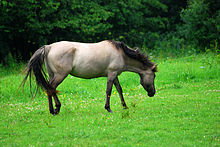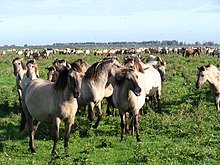Konik
| Konik | |
|---|---|

Konik |
|
| Important data | |
| Origin: | Poland |
| Main breeding area: | Poland (private, state and wilderness studs) |
| Distribution: | Mainly Central and Eastern Europe |
| Stick measure : | 130-140 cm |
| Colors : | Gray albums with wild drawings and gray-brown, Isabell, Schimmel, Brauner |
| Main application area: | Breeding and Agriculture |
The Konik (from the Polish : horses , small horse ) is a Ponyrasse from the Central and Eastern Europe. The ponies are very robust and are used both in agriculture and in maintaining numerous nature reserves such Geltinger Birk (Baltic Sea), Schmidt height (Koblenz) or the Brönnhof in Schweinfurt and in the Polish Bialowieza National Park , where they in extensive agriculture are held . The largest population lives in Oostvaardersplassen in the Netherlands in almost wild conditions.
Background information on horse evaluation and breeding can be found under: Exterior , interior and horse breeding .
Exterior
Koniks are black fallow horses with a dark eel line and dark legs. Sometimes there are fetlock stripes and a weak shoulder cross . Foxes and black horses are other color variants, and a certain proportion of the population has white markings. The head is medium in size and has a straight or slightly concave profile. The forelock is thick and framed by small ears. The short neck is heavy with a broad base and lush, thick long hair. The trunk of the Konik is long and has a pronounced arching of the ribs, the chest is wide and deep. The well-muscled croup is rather short and knocked off, the base of the tail is medium deep. The legs are short and strong with dry joints, hard hooves and a small drop of droppings .
The movements of the Konik are hard-working and persistent in all gaits. The Konik has a low level of jumping ability and is characterized by its high resistance.
interior
Koniks are seen as willing, calm and frugal. The breed is characterized by longevity. Koniks are a very people-friendly breed and are not shy even as animals grown in the wild. Foals in particular are often in contact with people. In a herd, Koniks behave dominantly towards other, even larger breeds.
Breeding history
Genetic studies contradict the view that the Konik is a surviving form of the wild horses of Eastern Europe. They share mtDNA with various other domestic horse breeds and their Y chromosome is identical to that of most other domestic horses.
The Konik is a Polish landrace that emerged from very robust landfills in the Biłgoraj region. Up until the 19th century, wild horse populations existed in Eastern Europe, especially in Poland, and were also hunted. It is still unclear whether these were real wild horses, feral horses or hybrids ( see: Tarpan ), but an influence from domestic horses has been proven. In any case, some of these wild horses were distributed to surrounding farmers by the local zoo in Zamość around 1806 , tamed and further bred with the local domestic horses. It is unlikely that these domestic horses were also strongly influenced by the wild horses, as farmers fought against such influence on their horses because of the stubborn behavior of the latter.
The poverty of the farmers in the region meant that horses were kept with very little human care, making them very robust lofts. As a result, they have proven themselves as work horses, especially as draft horses. During the First World War , these country horses played an important role in the transport of German and Russian troops and were henceforth called Panjepferde . These horses were predominantly black falcons , but there were also variants such as foxes or black horses.
From 1923 onwards, the Cracow professor of agriculture, Tadeusz Vetulani, became interested in the Panje horses of the Biłgoraj region and coined the name Konik ("little horse") for the breed, which gradually became a worldwide name. In the 1920s and 1930s, various state and private stud farms were established to promote the preservation of one of the few Polish regional breeds that is also a valuable workhorse.
In 1936, on the initiative of Vetulani, a Konik reserve was established in the Białowieża Primeval Forest. Vetulani was convinced that a reconstruction of the wild Eastern European horses could be generated from the Koniks through back- breeding and de-domestication . He wanted to achieve characteristics such as white winter coat, standing mane, herd instinct and year-round independence from humans less through breeding interventions than through natural selection . The Second World War temporarily ended Vetulani's project, which was later continued in Popielno in the form of a few human interventions. The frequent purchase of Koniks that had survived the war from various breeding locations (including Germany) established Popielno as the main breeding location for the breed in the 1950s. Contrary to popular belief, Vetulani's backbreeding experiment made only an insignificant contribution to today's Konik population.
From then on, Koniks were bred either in the stables or in reserves, but in both cases mostly under human breeding control. So, over the past few decades, the breed has been bred to be higher at shoulder to make it a more effective workhorse. The body, especially the head, was also "refined", i.e. H. bred leaner. Black horses and foxes as well as animals with white markings occur again and again due to the diverse breeding history of the breed. On the other hand, selection has been made since the 1990s, but the long-term elimination of these color variants turns out to be tedious, as these colors are recessive.
The parallel husbandry in stable breeding and reserve breeding made it possible to use the Konik to explore the effects of different breeding variants on the health and behavior of horses. Stallkoniks show laminitis and hay allergy much more often than their relatives outdoors.
Crossbreeding
In the inter-war period, the brothers Heinz Heck and Lutz Heck crossed Polish Koniks with other breeds such as Dülmen horses , Gotland horses , Icelandic horses and Przewalski wild horses in Germany . The resulting breed can be described as a rear horse .
The Dülmen horse , which is also often incorrectly referred to as a wild horse, has been mated to a large extent by Konik stallions in the recent past, so that both breeds are almost identical today.
Furthermore, the Konik is crossed by some breeders with Anglo-Arabs , warm-blooded and English thoroughbreds to improve the profitability of the breed .
See also
literature
- Tadeusz Jezierski, Zbigniew Jaworski: The Polish Konik. (= Die Neue Brehm-Bücherei. Volume 658). Westarp Sciences, Hohenwarsleben 2008, ISBN 3-89432-913-0 .
- Van Vuure, Cis: On the origin of the Polish konik and its relation to Dutch nature management. In Lutra. Volume 57, No. 2, 2014, pp. 111-130.
- Van Vuure, Cis: From kaikan to konik - Facts and perceptions surrounding the European wild horse and the Polish konik. Semper, Warszawa, 2015, p. 445. http://semper.istore.pl/en_US/p/From-kaikan-to-konik/23076145 .
Source reference
- ↑ a b c d e f g h i j Tadeusz Jezierski, Zbigniew Jaworski: The Polish Konik. (= Die Neue Brehm-Bücherei. Volume 658). Westarp Sciences, Hohenwarsleben 2008, ISBN 3-89432-913-0 .
- ↑ a b c Bunzel-Drüke, Finck, Kämmer, Luick, Reisinger, Riecken, Riedl, Scharf & Zimball: Wilde Weiden: Practical guidelines for year-round grazing in nature conservation and landscape development . Working group for biological environmental protection in the Soest district V. (ABU), Bad Sassendorf-Lohne, 2nd edition, 2009. ISBN 978-3-00-024385-1
- ↑ Jansen et al. 2002: Mitochondrial DNA and the origins of the domestic horse
- ↑ Cieslak et al. 2010: Origin and History of Mitochondrial DNA lineages in domestic horses
- ↑ Thomas Jansen: Investigations on the phylogeny and domestication of the domestic horse (Equus ferus f. Caballus) development of the tribe and geographical distribution. Dissertation to obtain the doctoral degree (Dr. rer. Nat.) Of the mathematical and natural science faculty of the Rheinische Friedrich-Wilhelms-Universität Bonn. Bonn, September 2002 ( PDF )


